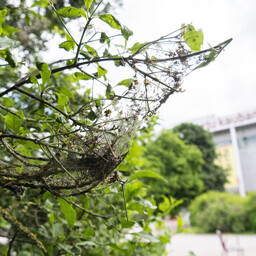Võrgendikoid on väikesed liblikad. Nad teevad puudele ja põõsastele võrgendipesi. Nende
röövikud elavad seal
. Mõnikord on
terve puu võrgendiga kaetud
.
röövikud elavad seal
Tõlge fraasile: röövikud elavad seal
EN
caterpillars live there
terve puu võrgendiga kaetud
Tõlge fraasile: terve puu võrgendiga kaetud
EN
the entire tree is covered with a tent
Eestis on erinevaid võrgendikoi liike. Näiteks
toominga-võrgendikoi
ja
paju-võrgendikoi
. Iga liik sööb erinevaid puid või põõsaid.
toominga-võrgendikoi
Tõlge fraasile: toominga-võrgendikoi
EN
bird cherry tent caterpillar
paju-võrgendikoi
Tõlge fraasile: paju-võrgendikoi
EN
willow tent caterpillar
Võrgendikoid on väikesed, valged mustade täppidega liblikad. Nad on kuni 15 mm pikad. Nende tegevus on näha puudel hallide võrgenditena.
Võrgendikoid elavad ühe aasta. Nad lendavad suvel ja munevad puudele. Sügisel kooruvad röövikud, kes talvituvad. Kevadel nad söövad noori lehti.
Mõnikord on võrgendikoosid palju. Siis nad võivad puud paljaks süüa. Kuid
puud kasvavad tavaliselt uuesti välja
.
puud kasvavad tavaliselt uuesti välja
Tõlge fraasile: puud kasvavad tavaliselt uuesti välja
EN
trees usually grow back
Võrgendikoosid on Eestis juba ammu teada. 1749. aastal käskis Senat neid hävitada. Tänapäeval ei ole neist suurt ohtu. Puud taastuvad kiiresti.
Kui võrgendikoosid on liiga palju, saab neid tõrjuda. Näiteks õunapuudel kasutatakse pritsimist. Üksikuid pesasid saab ka
käsitsi eemaldada
.
käsitsi eemaldada
Tõlge fraasile: käsitsi eemaldada
EN
remove manually
Enamasti ei pea linlased
võrgendikoid
e pärast muretsema. Puud ja põõsad taastuvad ise. Suve lõpuks on võrgendid sageli juba kadunud.
võrgendikoid
Tõlge fraasile: võrgendikoid
EN
tent caterpillars
Webworm moths are small butterflies. They create web nests on trees and shrubs. Their larvae live there. Sometimes an entire tree is covered with webs.
There are different species of webworm moths in Estonia. For example, the bird-cherry ermine moth and the willow ermine moth. Each species feeds on different trees or shrubs.
Webworm moths are small, white butterflies with black spots. They are up to 15 mm long. Their activity is visible on trees as gray webs.
Webworm moths live for one year. They fly in summer and lay eggs on trees. In autumn, the larvae hatch and overwinter. In spring, they feed on young leaves.
Sometimes there are many webworm moths. Then they can defoliate trees. But trees usually grow back.
Webworm moths have been known in Estonia for a long time. In 1749, the Senate ordered their destruction. Today, they are not a major threat. Trees recover quickly.
If there are too many webworm moths, they can be controlled. For example, apple trees are sprayed. Individual nests can also be removed manually.
Mostly, city dwellers don't need to worry about webworm moths. Trees and shrubs recover on their own. By the end of summer, the webs are often already gone.

